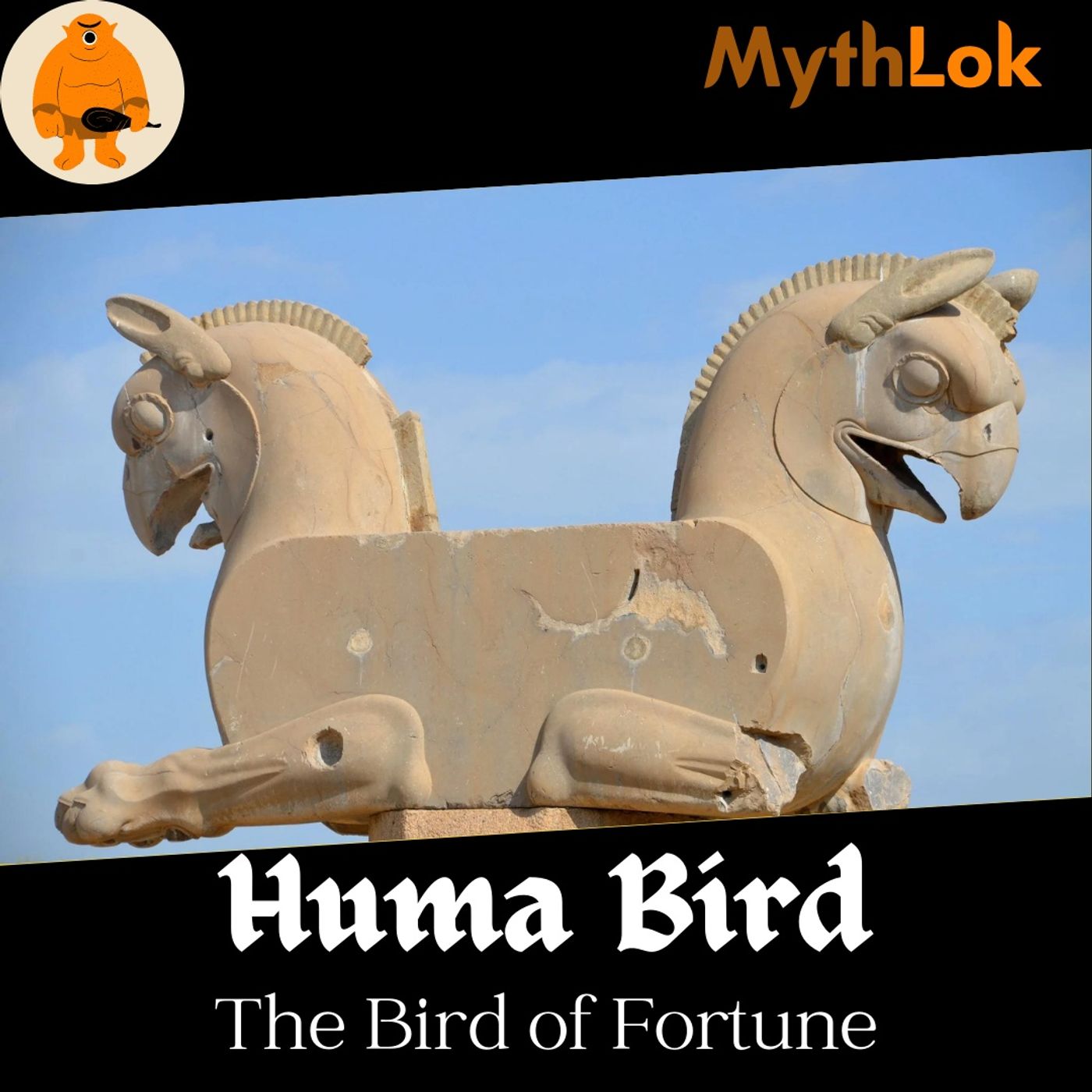
Mythlok - The Home of Mythology
History

The Huma Bird is a mythical bird of Iranian folklore and Sufi and Diwan poetry. Although it is believed to live in the sky, it never alights on the ground. According to some legends, the bird never comes to rest. It lives its life high in the clouds and never steps foot on the earth.
The bird is often referred to as a "bird of paradise" in Ottoman poetry. Early descriptions of the Paradisaeidae group portrayed the animals as having no wings or legs. The Conference of the Birds by Attar of Nishapur depicted the bird as a creature that was reluctant to embark on a journey, as it would supposedly compromise kingship over those it flew over. This concept is also used in Iranian literature as a metaphor for Arabs.
The feather-like features of the Huma bird were associated with the kingship-bestowing function in Indian mythology. In other words, the feathers on the heads of rulers were believed to be the plumage of this bird. In Turkish folk literature as well, the bird has a prominent place. In some works, the creature is depicted as a symbol of great fortune.
The bird is believed to be a phoenix-like creature that consumes itself in fire every hundred years. It has the distinct characteristics of a female and male bird is considered to be a union of both forms. Both male and female sides of the bird have one wing and a leg each.
It is said that this unique bird spends it entire life in high sky and gets down on to the ground only to feed on bones. It breeds in the sky and lays eggs when in the air which start falling down towards the land at great speed. Before the eggs hit the ground they hatch in the air and in the chick's downward journey it develops its eyes. On reaching the vicinity of earth, the chick becomes consciousness and gives out a shrill cry with the fear of dashing to the ground to encounter death. It stabilizes its movement and takes flight upwards towards its safest sanctuary, its mother.
Although predominantly known as Huma or the Huma bird, it is also known as Homa in Indian mythology. This is also related to the meaning of the the word Homa which is that of a sacrificial fire. This is in line with the tendency of the Huma Bird to burn itself to ashes like the phoenix.
Catching this bird is considered to be beyond the imagination of most people. However, since it is believed that the person who kills it will die in forty days, the capture is never attempted. It is also believed that if the shadow of the Huma Bird falls on someone, he or she is blessed with good fortune. If the bird decides to sit on someone, it is considered to be an appointment of kingship.
The Huma Bird has been associated with the European griffin and inspired many stories and folktales that are popular even today. Iran Air the official aircraft carrier of Iran used the Huma Bird in its insignia. The Uzbek Coat of Arms also feature the bird.
Read about the Huma Bird at https://mythlok.com/huma-bird/
view more
The bird is often referred to as a "bird of paradise" in Ottoman poetry. Early descriptions of the Paradisaeidae group portrayed the animals as having no wings or legs. The Conference of the Birds by Attar of Nishapur depicted the bird as a creature that was reluctant to embark on a journey, as it would supposedly compromise kingship over those it flew over. This concept is also used in Iranian literature as a metaphor for Arabs.
The feather-like features of the Huma bird were associated with the kingship-bestowing function in Indian mythology. In other words, the feathers on the heads of rulers were believed to be the plumage of this bird. In Turkish folk literature as well, the bird has a prominent place. In some works, the creature is depicted as a symbol of great fortune.
The bird is believed to be a phoenix-like creature that consumes itself in fire every hundred years. It has the distinct characteristics of a female and male bird is considered to be a union of both forms. Both male and female sides of the bird have one wing and a leg each.
It is said that this unique bird spends it entire life in high sky and gets down on to the ground only to feed on bones. It breeds in the sky and lays eggs when in the air which start falling down towards the land at great speed. Before the eggs hit the ground they hatch in the air and in the chick's downward journey it develops its eyes. On reaching the vicinity of earth, the chick becomes consciousness and gives out a shrill cry with the fear of dashing to the ground to encounter death. It stabilizes its movement and takes flight upwards towards its safest sanctuary, its mother.
Although predominantly known as Huma or the Huma bird, it is also known as Homa in Indian mythology. This is also related to the meaning of the the word Homa which is that of a sacrificial fire. This is in line with the tendency of the Huma Bird to burn itself to ashes like the phoenix.
Catching this bird is considered to be beyond the imagination of most people. However, since it is believed that the person who kills it will die in forty days, the capture is never attempted. It is also believed that if the shadow of the Huma Bird falls on someone, he or she is blessed with good fortune. If the bird decides to sit on someone, it is considered to be an appointment of kingship.
The Huma Bird has been associated with the European griffin and inspired many stories and folktales that are popular even today. Iran Air the official aircraft carrier of Iran used the Huma Bird in its insignia. The Uzbek Coat of Arms also feature the bird.
Read about the Huma Bird at https://mythlok.com/huma-bird/
More Episodes
Stribog : The Wind God
 2022-10-20
2022-10-20
 2022-10-20
2022-10-20
Hercules : The Roman Hero
 2022-10-19
2022-10-19
 2022-10-19
2022-10-19
Heracles : The Greek Hero
 2022-10-18
2022-10-18
 2022-10-18
2022-10-18
Sphinx : The Riddler
 2022-10-17
2022-10-17
 2022-10-17
2022-10-17
Sphinx : The Guardian of the Pyramids
 2022-10-14
2022-10-14
 2022-10-14
2022-10-14
Lono : The God of Agriculture
 2022-10-13
2022-10-13
 2022-10-13
2022-10-13
Mixcoatl : The God of the Hunt
 2022-10-12
2022-10-12
 2022-10-12
2022-10-12
Mercury : The Messenger God
 2022-10-11
2022-10-11
 2022-10-11
2022-10-11
Ninurta : God of Agriculture
 2022-10-10
2022-10-10
 2022-10-10
2022-10-10
Phaya Nak : The Water Serpent
 2022-10-04
2022-10-04
 2022-10-04
2022-10-04
Kane : The Creator God
 2022-10-03
2022-10-03
 2022-10-03
2022-10-03
Simurgh : The Giant Bird
 2022-09-21
2022-09-21
 2022-09-21
2022-09-21
Ishara : The Scorpion Goddess
 2022-09-20
2022-09-20
 2022-09-20
2022-09-20
Phosop : The Rice Goddess
 2022-09-19
2022-09-19
 2022-09-19
2022-09-19
Puteri Walinong Sari : The Warrior Princess
 2022-09-15
2022-09-15
 2022-09-15
2022-09-15
Badang : The Strongest Man
 2022-09-14
2022-09-14
 2022-09-14
2022-09-14
Makara : The Elephant Crocodile
 2022-09-12
2022-09-12
 2022-09-12
2022-09-12
Nafanua :The Warrior Princess
 2022-09-09
2022-09-09
 2022-09-09
2022-09-09
Mayari : The Moon Goddess
 2022-09-08
2022-09-08
 2022-09-08
2022-09-08
Degei : The Supreme God
 2022-09-07
2022-09-07
 2022-09-07
2022-09-07
012345678910111213141516171819
Create your
podcast in
minutes
- Full-featured podcast site
- Unlimited storage and bandwidth
- Comprehensive podcast stats
- Distribute to Apple Podcasts, Spotify, and more
- Make money with your podcast
It is Free
- Privacy Policy
- Cookie Policy
- Terms of Use
- Consent Preferences
- Copyright © 2015-2024 Podbean.com





